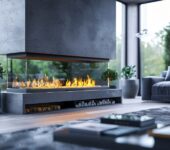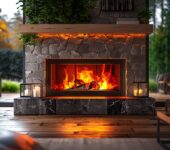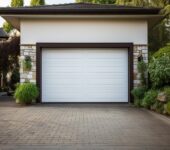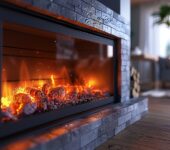Table of Contents
- 1 Here is a Breakdown of the Information You Need to Know
- 2 How Does a Gas Fireplace Work?
- 3 What Causes Gas Leaks in a Gas Fireplace?
- 4 How to Detect a Gas Leak in a Gas Fireplace?
- 5 What to Do if You Suspect a Gas Leak in Your Gas Fireplace?
- 6 Prevention Tips to Avoid Gas Leaks in a Gas Fireplace
- 7 Frequently Asked Questions
Gas fireplaces provide warmth and ambiance to a home, but it is crucial to ensure their safe operation. Gas leaks in a gas fireplace can pose a significant risk to your household’s safety, so it is important to know how to detect them and what steps to take in case of suspicion. With an understanding of how gas fireplaces work and the common causes of gas leaks, you can better safeguard your home.
Here is a Breakdown of the Information You Need to Know
How Does a Gas Fireplace Work?
Gas fireplaces rely on a steady supply of natural gas or propane to produce flames and heat. This fuel is ignited and controlled by a gas valve and burner system. A chimney or vent directs the byproducts, including carbon monoxide, out of the home.
What Causes Gas Leaks in a Gas Fireplace?
Several factors can contribute to gas leaks in a gas fireplace. Some common causes include damaged gas lines or connections, malfunctioning gas valves, and improper ventilation. Addressing these issues promptly is essential for maintaining safety.
How to Detect a Gas Leak in a Gas Fireplace?
Recognizing the signs of a gas leak is crucial to ensuring a prompt response. Some indications of a gas leak in a gas fireplace include the distinct smell of gas, a hissing sound near the fireplace, and the presence of soot or discoloration around the fireplace or chimney area.
What to Do if You Suspect a Gas Leak in Your Gas Fireplace?
If you suspect a gas leak in your gas fireplace, it is important to prioritize safety. Leave the area immediately, avoiding the creation of sparks or flames. Once in a safe location, call a professional to assess and repair the gas fireplace.
Prevention Tips to Avoid Gas Leaks in a Gas Fireplace
Preventing gas leaks in a gas fireplace is essential for maintaining the safety of your home. Regular maintenance and inspection, proper ventilation of the fireplace, and timely repairs are all crucial preventive measures to ensure the safe operation of your gas fireplace.
By understanding how gas fireplaces work, being aware of the signs of gas leaks, and taking necessary preventative measures, you can enjoy the warmth and comfort of your gas fireplace while keeping your home and loved ones safe.
How Does a Gas Fireplace Work?
A gas fireplace operates using the following steps:
- Gas Supply: The gas fireplace is connected to a gas supply line, usually natural gas or propane.
- Ignition: When the fireplace is turned on, the ignition system sparks to ignite the gas. The ignition can be manual or electronic, depending on the fireplace model.
- Burner: Once ignited, the gas flows into the burner, which is responsible for producing the flames and heat.
- Logs or Firebed: Some gas fireplaces have artificial logs or firebeds made of ceramic or other materials. These are strategically placed on top of the burner to create a realistic appearance of a traditional wood-burning fireplace.
- Ventilation: Gas fireplaces typically have a ventilation system, which may include a chimney, flue, or direct vent. This system ensures that any harmful combustion byproducts, such as carbon monoxide, are safely expelled outside.
- Controls: Gas fireplaces come with various controls to adjust the flame height, heat output, and other features. These controls can be in the form of knobs, switches, or remote controls.
- Thermostat: Some gas fireplaces have a built-in thermostat that allows the user to set a desired temperature. The fireplace will automatically adjust its heat output to maintain the selected temperature.
- Shut-off Valve: A gas fireplace is equipped with a shut-off valve that allows the user to turn off the gas supply in case of an emergency or when the fireplace is not in use.
It is important to always follow the manufacturer’s instructions and have regular maintenance to ensure the safe and efficient operation of a gas fireplace.
What Causes Gas Leaks in a Gas Fireplace?
Gas leaks in a gas fireplace can be dangerous and pose a serious risk. In this section, we will uncover the different causes of gas leaks, shedding light on damaged gas lines or connections, malfunctioning gas valves, and improper ventilation. By understanding the potential culprits behind gas leaks in a gas fireplace, you’ll arm yourself with essential knowledge to detect and prevent such incidents. Stay informed and ensure the safety of your home and loved ones.
Damaged Gas Lines or Connections
When dealing with damaged gas lines or connections in a gas fireplace, it is crucial to take immediate action to ensure safety. Here are the steps to follow:
- First and foremost, if you detect the odor of gas or suspect a gas leak, evacuate the area immediately.
- Avoid creating any sparks or flames, as these can potentially ignite the gas.
- Contact a professional gas technician or your local gas company to report the issue and request assistance.
- While waiting for professional help, refrain from using any electrical devices or switches that could generate a spark.
- To identify the source of the gas leak, experts may perform a bubble test. This involves applying a solution of soapy water to the connections and lines. If bubbles form, it signifies a leak.
- Once the gas leak has been pinpointed, the damaged gas lines or connections must be repaired or replaced. This task should only be performed by a trained and certified professional.
- Following the completion of the repairs, it is essential to arrange regular maintenance and inspections to prevent future gas leaks and ensure the safe operation of your gas fireplace.
Remember, gas leaks can be extremely hazardous and may potentially result in carbon monoxide poisoning. Hence, it is imperative to prioritize safety and seek professional assistance when dealing with damaged gas lines or connections in a gas fireplace.
Malfunctioning Gas Valves
| Issue: Malfunctioning Gas Valves | Effect: Various problems can occur | Solution: Regular maintenance and inspection can prevent safety hazards |
| Issue: Gas valve fails to open | Effect: Gas flow is disrupted | Solution: Check for obstructions in the valve or replace the faulty valve |
| Issue: Gas valve fails to close | Effect: Gas continues to flow, increasing the risk of leaks | Solution: Repair or replace the faulty valve to ensure proper closing |
| Issue: Malfunctioning control valve | Effect: Inconsistent gas flow | Solution: Inspect the control valve for damage or dirt and clean or replace as necessary |
| Issue: Pressure regulator failure | Effect: Unstable gas flow | Solution: Replace the faulty pressure regulator to maintain stable gas pressure |
Malfunctioning gas valves in a gas fireplace can lead to various problems. If the gas valve fails to open, it disrupts the flow of gas, preventing the fireplace from igniting. This issue can be resolved by checking for any obstructions in the valve or replacing a faulty valve.
On the other hand, if the gas valve fails to close, it allows gas to continue flowing even when the fireplace is turned off, increasing the risk of gas leaks. To address this issue, it is crucial to repair or replace the faulty valve to ensure proper closing.
Another problem could be a malfunctioning control valve, which can result in inconsistent gas flow. Inspecting the control valve for damage or dirt and cleaning or replacing it as necessary can help maintain consistent gas flow.
A failure in the pressure regulator can lead to unstable gas flow. It is important to replace the faulty pressure regulator to ensure that the gas pressure remains stable.
Regular maintenance and inspection of gas valves can help identify any malfunctions early on and prevent potential gas leaks or other safety hazards associated with malfunctioning gas valves.
Improper Ventilation
Proper ventilation is crucial for the safe operation of a gas fireplace. Failure to ensure proper ventilation can result in serious safety hazards. The accumulation of harmful gases such as carbon monoxide in a room can lead to carbon monoxide poisoning, which can be fatal. Additionally, incomplete combustion can cause the buildup of other byproducts, leading to poor air quality.
There are various factors that can contribute to improper ventilation in a gas fireplace. One common cause is a blocked chimney or vent, where debris or obstructions hinder the airflow, causing the gases to accumulate indoors. Another factor is the size of the room where the fireplace is installed. If the room is too small, there may not be enough air circulation to effectively dissipate the gases. Furthermore, a malfunctioning vent damper or failure to fully open the damper can also impede proper ventilation.
To prevent improper ventilation, regular maintenance and inspection of the gas fireplace are essential. This ensures that the venting system remains clear and functions properly. Adequate ventilation in the room where the fireplace is located is also crucial. It is important to ensure sufficient air circulation and consider installing a carbon monoxide detector for enhanced safety.
A pertinent fact to consider is that carbon monoxide poisoning is responsible for over 400 deaths and causes around 20,000 emergency room visits in the United States each year, according to the Centers for Disease Control and Prevention. Thus, proper ventilation in gas fireplaces is indispensable to prevent this perilous situation.
How to Detect a Gas Leak in a Gas Fireplace?
Concerned about a potential gas leak in your gas fireplace? Let’s dive into the art of detection and equip you with the knowledge to stay safe. From being vigilant for the telltale scent of gas to being mindful of any hissing sounds, we’ll explore the various signs you should be on the lookout for. We’ll discuss the possible presence of soot or discoloration, giving you a comprehensive understanding of how to detect a gas leak in your gas fireplace. Safety first, folks!
Smell of Gas
The smell of gas coming from a gas fireplace is a significant indication of a potential gas leak. Gas leaks in a gas fireplace can be dangerous and should be addressed immediately. The smell of gas is often described as a rotten egg or sulfur-like odor. If you detect this smell, it is crucial to take immediate action to ensure your safety.
Here’s what you should do if you smell gas coming from your gas fireplace:
- Open windows and doors to allow for proper ventilation and prevent the buildup of gas.
- Avoid creating sparks or flames, as this can ignite the gas in the air.
- Leave the area and evacuate everyone in the vicinity, including pets.
- Do not use electrical switches, lighters, or any other electrical devices, as they can potentially ignite the gas.
- Once you are at a safe distance, call a professional gas technician or the gas company to report the gas leak and seek assistance.
Pro-tip: It is essential to have a methane detector installed near your gas fireplace to detect any gas leaks promptly. Regularly test the detector to ensure it is functioning correctly. Consider scheduling regular maintenance and inspections for your gas fireplace to prevent gas leaks and ensure its safe operation.
Hissing Sound
The sound of hissing emanating from a gas fireplace may serve as an indication of a potential gas leak. It is imperative to bear in mind the following key points:
– The presence of a hissing sound in your gas fireplace could be an indicator of a gas leak.
– Gas leaks may occur due to impaired gas lines or connections, malfunctioning gas valves, or inadequate ventilation.
– It is crucial to treat the hissing sound with utmost seriousness, refraining from disregarding it, as gas leaks can be perilous and result in carbon monoxide poisoning.
– Upon hearing a hissing sound, it is essential to take immediate action to ensure your own safety.
– Initially, vacate the area to prevent any interaction with the potentially hazardous gas.
– Refrain from creating sparks or flames as they possess the ability to ignite any leaked gas.
– Seek the assistance of a professional gas plumber or technician to assess the situation and rectify the gas leak.
– To prevent future gas leaks, it is advisable to take preventative measures such as regular maintenance and inspection, ensuring proper ventilation, and timely repairs.
It is crucial to remember that gas leaks can pose hazardous consequences and should be promptly addressed. Should you detect a hissing sound or suspect the occurrence of a gas leak in your gas fireplace, prioritize your safety and follow the necessary steps to safeguard yourself and your household.
Soot or Discoloration
- Soot or discoloration in a gas fireplace can indicate potential issues or problems that need to be addressed.
- Buildup of soot can be caused by incomplete combustion, resulting from improper burner adjustment or insufficient oxygen.
- Discoloration on the walls or mantel near the fireplace can be a sign of excessive heat or poor ventilation.
- If you observe soot or discoloration, it is crucial to take action to prevent further damage or potential safety hazards.
- Regular maintenance and cleaning of the gas fireplace can help prevent the accumulation of soot and discoloration.
- Ensure proper ventilation by keeping the air vents and chimney clear of debris or blockages.
- If you notice significant soot or discoloration, it is recommended to consult a professional gas fireplace technician to inspect and repair any potential issues.
- Do not attempt to clean or remove soot buildup yourself, as it may require specialized tools or knowledge.
- Addressing soot or discoloration promptly can help maintain the efficiency and safety of your gas fireplace.
What to Do if You Suspect a Gas Leak in Your Gas Fireplace?
If you ever suspect a gas leak in your gas fireplace, it’s crucial to know exactly what to do. This section is all about taking the necessary steps to handle such a situation in the safest manner possible. From promptly leaving the area to avoiding any sparks or flames, we’ll cover the essential actions you need to take. And of course, we’ll emphasize the importance of calling a professional to address the situation. Don’t panic, but be prepared to act responsibly and ensure the safety of yourself and your home.
Leave the Area
Leaving the area is crucial if you suspect a gas leak in your gas fireplace. It is important to prioritize safety and remove yourself from potential harm and ensure your well-being.
When detecting a gas leak, it is imperative to avoid creating any sparks or flames. This means refraining from using electrical switches or appliances that may cause sparks and ignite the leaked gas. Additionally, it is essential to steer clear of smoking or open flames near the gas leak.
Once you have promptly left the area and ensured the absence of potential ignition sources nearby, it is crucial to contact a professional. Gas leaks should only be addressed by trained individuals who can safely identify and resolve the issue. Seeking the assistance of a gas professional ensures that the gas leak is properly handled and any necessary repairs are conducted.
Remember, above all, prioritize your safety. If you suspect a gas leak in your gas fireplace, leave the area immediately, avoid creating sparks or flames, and seek the expertise of a professional to assess and resolve the issue.
Fact: Carbon monoxide, a colorless and odorless gas emitted by gas fireplaces, can be highly toxic and even fatal if inhaled in high concentrations. It is of utmost importance to have carbon monoxide detectors installed in your home to alert you to the presence of dangerous carbon monoxide levels.
Avoid Creating Sparks or Flames
When it comes to using a gas fireplace, it’s important to follow safety procedures to avoid creating sparks or flames that could potentially cause a gas leak. Here are some tips to help you stay safe:
|
By following these precautions and regularly maintaining your gas fireplace, you can avoid creating sparks or flames that may lead to a gas leak and ensure the safety of your home.
Call a Professional
When it comes to dealing with a gas leak in your gas fireplace, it is crucial to call a professional immediately. Calling a professional from Dreifuss Fireplaces is essential because they have the necessary tools and equipment to detect and fix a gas leak effectively. They have the knowledge, skills, and tools necessary to detect and address the issue promptly and safely.
Gas leaks can be extremely dangerous and should not be taken lightly. If you suspect a gas leak in your gas fireplace, calling a professional is the best course of action. Don’t try to handle a gas leak yourself, as it can be hazardous. It’s always better to rely on a qualified professional to ensure your safety and the safety of your home. A trained and certified gas professional will have the knowledge and expertise to safely handle the situation. They will be able to identify the source of the leak, whether it’s a damaged gas line or a malfunctioning gas valve.
Attempting to fix a gas leak on your own can be risky and may lead to further complications or even accidents. A professional will also ensure that proper safety procedures are followed. They will thoroughly inspect your gas fireplace and check for any signs of carbon monoxide poisoning. By relying on their expertise, you can have peace of mind knowing that your gas fireplace is in safe working condition.
Prevention Tips to Avoid Gas Leaks in a Gas Fireplace
Regular maintenance, proper ventilation, and timely repairs are the key to preventing gas leaks in a gas fireplace. By understanding and implementing these essential prevention tips, you can ensure the safety and efficiency of your gas fireplace. So, let’s dive into the crucial sub-sections that will guide you towards a gas leak-free environment in your home.
Regular Maintenance and Inspection
- Regularly inspect the gas fireplace to ensure everything is in proper working order.
- Perform regular cleaning of the gas logs and burner to remove any debris or buildup that could affect the operation of the fireplace.
- Check for any signs of wear or damage in the gas lines or connections during regular maintenance and inspection. Look for cracks, leaks, or loose fittings.
- As part of the regular maintenance routine, test the gas valves to make sure they are functioning correctly. Ensure they open and close smoothly without any resistance.
- To maintain proper ventilation, regularly check the chimney or flue for any blockages or obstructions. Clear any debris that could hinder the flow of gases during regular maintenance and inspection.
Regular maintenance and inspection are essential for the safe and efficient operation of a gas fireplace. By following these steps, you can proactively identify any potential issues and address them promptly before they become bigger problems. Additionally, regular cleaning, checking for gas leaks, and ensuring proper ventilation will help prevent accidents and maintain the overall integrity of the fireplace.
Remember, it is crucial to have a professional gas technician perform any repairs or maintenance tasks beyond regular cleaning and inspection. They have the expertise and knowledge to handle gas-related issues safely and effectively. Taking these preventative measures will provide you with peace of mind and ensure the continued enjoyment of your gas fireplace.
Proper Ventilation
Proper ventilation is absolutely crucial when it comes to gas fireplaces. Here are some key factors to take into consideration:
- Make sure you have an adequate supply of fresh air for combustion. Gas fireplaces rely on oxygen, so it’s important to ensure that the room is well-ventilated to maintain a steady flow of air.
- Keep the vents free from any obstructions. Blocked vents can restrict airflow, leading to inefficient combustion and potentially hazardous gas leaks. It’s important to regularly inspect and clean the vents to prevent any blockages.
- Installing a carbon monoxide detector is a must. Carbon monoxide is a dangerous byproduct of gas combustion, and having a detector in the room will alert you to any accumulation of this colorless and odorless gas.
- Always follow the specific ventilation guidelines provided by the manufacturer. These guidelines often include recommended distances from windows, walls, and other combustible materials. Adhering to these instructions is crucial for safe operation.
- If you have any doubts about the ventilation requirements or suspect any issues, it is best to seek professional assistance from a qualified gas expert. They can evaluate your fireplace setup and ensure proper ventilation.
Fact: Inadequate ventilation in a gas fireplace can result in incomplete combustion, leading to the production of carbon monoxide. This poisonous gas can cause a range of symptoms such as headaches, dizziness, nausea, and in severe cases, even death. Thus, proper ventilation is of utmost importance to ensure the safety of everyone near a gas fireplace.
Timely Repairs
Timely repairs are crucial when it comes to gas fireplaces. Regular maintenance and prompt repairs can prevent potential gas leaks and ensure the safe operation of your fireplace. Here are some important factors to consider:
|
Timely repairs can prevent gas leaks and ensure the safe operation of your gas fireplace. By addressing any issues promptly and following proper safety procedures, you can enjoy the comfort and warmth of your fireplace without any concerns.
True History
A family in a small town experienced a gas leak in their gas fireplace due to a damaged gas line. The gas odor was detected by their methane detector, and they promptly called a professional gas technician. The technician quickly identified the issue and repaired the damaged gas line. The family was relieved to have addressed the problem in a timely manner, ensuring their safety and preventing any further complications. Regular maintenance and timely repairs played a crucial role in maintaining the safety and efficiency of their gas fireplace.
Frequently Asked Questions
1. How can I detect if my gas fireplace has a gas leak?
To detect a gas leak in your gas fireplace, you can perform a simple test using a soapy mixture. Apply the mixture to the gas valve and look for the formation of bubbles. If bubbles appear, it indicates a gas leak. Other signs include a hissing sound near the fireplace and a smell of rotten eggs.
2. What should I do if I suspect a gas leak in my gas fireplace?
If you suspect a gas leak in your gas fireplace, it is important to take immediate action for your safety. First, shut off all electrical appliances and open doors and windows to ventilate the area. Next, turn off the main gas valve and leave the premises. Finally, call a professional gas technician or the emergency gas line to report the issue and seek assistance.
3. What causes gas leaks in gas fireplaces?
Gas leaks in gas fireplaces can be caused by various factors. These include damage to the gas valve, wear and tear over time, the wrong size valve being installed, or issues with the gas line. Regular maintenance and inspection of the fireplace and its components can help identify and prevent potential gas leaks.
4. Can a gas leak from a fireplace cause health problems?
Yes, a gas leak from a fireplace can pose health risks. Inhaling natural gas can lead to physical symptoms such as headaches, dizziness, difficulty breathing, and nausea. In severe cases, exposure to high levels of gas can cause brain damage or even be fatal. Therefore, it is crucial to promptly address and fix any gas leaks in your gas fireplace.
5. How can I prevent gas leaks in my gas fireplace?
To prevent gas leaks in your gas fireplace, it is important to regularly test and maintain the gas valve. Check for any signs of wear or damage and ensure the valve is fully closed when not in use. Additionally, consider installing carbon monoxide detectors and natural gas detectors in your home to quickly detect and alert you to any gas leaks or unsafe levels of gas.
6. How much does it cost to repair a leaking gas fireplace?
The cost to repair a leaking gas fireplace can vary depending on the extent of the damage and the necessary repairs. On average, the cost can range from $150 to $800. However, if excavation or major repairs are needed, the cost can be higher. It is best to consult a professional gas technician to assess the issue and provide an accurate cost estimate.
Latest Articles

Garage Door With Glass Windows: Merge Aesthetics With Practicality
Table of Contents1 What Is a Garage Door with Glass Windows?2 What Are the Types of Glass Used for Garage Doors?3 What Are the Benefits

How Many Fireplaces Can I Have In My Home?
Table of Contents1 What Is a Fireplace?2 What Are the Different Types of Fireplaces?3 How Many Fireplaces Can You Have in Your Home?4 What Are
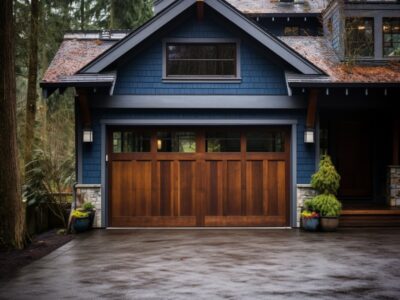
Window Garage Door: Framing Views, Enhancing Aesthetics
Table of Contents1 What Is a Window Garage Door?2 How Does a Window Garage Door Work?3 What Are the Benefits of Having a Window Garage







